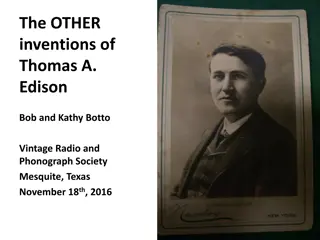Understanding Types of Lamps: Incandescent vs Halogen
Explore the world of lighting with a detailed comparison between incandescent and halogen lamps. Learn about their unique characteristics, efficiency, and usage to make informed decisions for your lighting needs.
Download Presentation

Please find below an Image/Link to download the presentation.
The content on the website is provided AS IS for your information and personal use only. It may not be sold, licensed, or shared on other websites without obtaining consent from the author. Download presentation by click this link. If you encounter any issues during the download, it is possible that the publisher has removed the file from their server.
E N D
Presentation Transcript
VADODARA INSTITUTE OF ENGINEERING KOTAMBI-391510 VADODARA ACTIVE LEARNING ASSIIGMENT TYPES OF LAMP MADE BY: PATEL TWINKLE (13ELEE160) KARANSIGH PANCHAL (13ELEE156) BARIYA PARESH (13ELEE157) PATEL BHARGAV (13ELEE164) SUBJECT:ELEMENTS OF ELECTRICAL ENGG. SUBJECE CODE:2110005 DISCIPLINE:EE-2 BE-1 -GUIDED BY: SHANKAR NOTANI
TYPES OF LAMP Incandescent Halogen lamp Fluorescent lamp Compact Fluorescent Lamps High-Intensity Discharge Lamps Low-Pressure Sodium Lamps LED (Light Emitting Diodes)
INCANCENTDES Incandescent bulbs produce a warm light that is very steady and stable. They are the most common bulb you will find in homes. Most standard incandescent bulbs last anywhere form 700-1000 hours, and many are colored soft white to diffuse light. Incandescent bulbs have a filament, usually tungsten, that heats up as electricity passes through. eTopLighting (5) Bulbs, J Type 78mm Double Ended T3 Halogen Light Bulb 120V 150W 120 Volts 150 Watt
While the main result of an incandescent bulb is heat, it makes quite a lot of light as a byproduct. Incandescent bulbs are the most inefficient bulb because most of the energy used to produce light is actually used to produce heat. Because this heat makes the filament fragile, many bulbs burn out at the end of their life when a sudden surge of power (such as the flick of a switch to turn them on) breaks the filament.
HALOGEN LAMP Under Cabinet Fluorescent Light Stick, 24" White Halogen bulbs are based on the same principle as incandescent bulbs. While incandescent bulbs are filled with an argon/nitrogen mixture, halogen bulbs are filled with krypton gas. The tungsten filament in a halogen bulb lasts longer because the filament stays stronger. Halogen bulbs are much brighter than incandescent, and are much more energy efficient for the amount of light produced.
Halogen bulbs can get very hot, and must be placed in areas without flammable materials nearby. They have a life of a little bit longer than an incandescent and must not be touched because the oils from fingers weakens the glass and can cause the bulb to explode.
USE OF HALOGEN LAMP USE OF HALOGEN LAMP Use a halogen bulb when more light than an incandescent can produce is needed. Halogens produce a light that is more similar to daylight and can be used to generate light for crafts and hobbies.
FLUORESCENT LAMP A fluorescent lamp or fluorescent tube is a low pressure mercury-vapor gas-discharge lamp that uses fluorescence to produce visible light. An electric current in the gas excites mercury vapor which produces short- wave ultraviolet light that then causes a phosphor coating on the inside of the bulb to fluoresce, producing visible light. A fluorescent lamp converts electrical power into useful light much more efficiently than incandescent lamps. The luminous efficacy of a fluorescent light bulb can exceed 100 lumens per watt, several times the efficacy of an incandescent bulb with comparable light output.
Fluorescent lamp fixtures are more costly than incandescent lamps because they require a ballast to regulate the current through the lamp, but the lower energy cost typically offsets the higher initial cost. The compact fluorescent lamp is now available in the same popular sizes as incandescent and is used as an energy-saving alternative in homes. Because they contain mercury, many fluorescent lamps are classified as hazardous waste. The United States Environmental Protection Agency recommends that fluorescent lamps be segregated from general waste for recycling or safe disposal.[3]
FLUORESCENT LAMP
USE OF FLUORESCNT LAMP Fluorescent lights should be used when a large amount of light is needed and where heating up the room is undesirable. They are very good for use in garages, basements and workshops. True day light OTT lights can be used for jewelry making and suggestions for using them are found in my guide on planning your jewelry workstation.
LED (light emitting diode) LED bulbs are the light of the future. They do not have a filament and can give off nearly white light. While they don't produce enough light to compete with CFL bulbs, they consume the least amount of electricity and produce the least amount of heat. LED bulbs have a very long life span and since LED technology is advancing rapidly, they should be the light of choice for residential applications in the near future.
LED bulbs can come in a wide variety of colors and can be used when colored accent lighting is needed. Because of the large initial cost, but low operating cost and long life, LED lights are being used more and more to replace incandescent bulbs every day.























